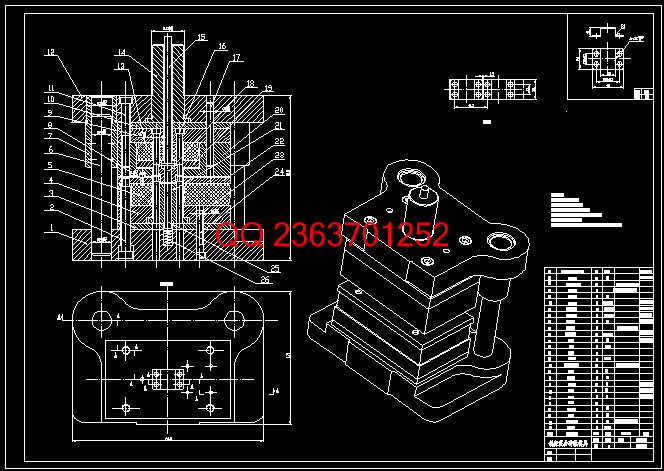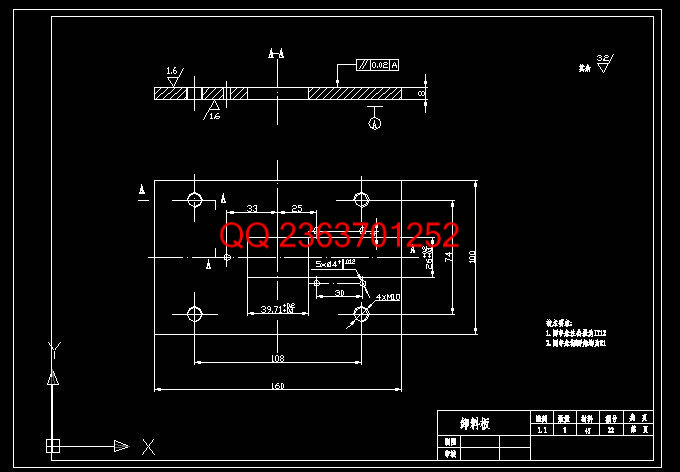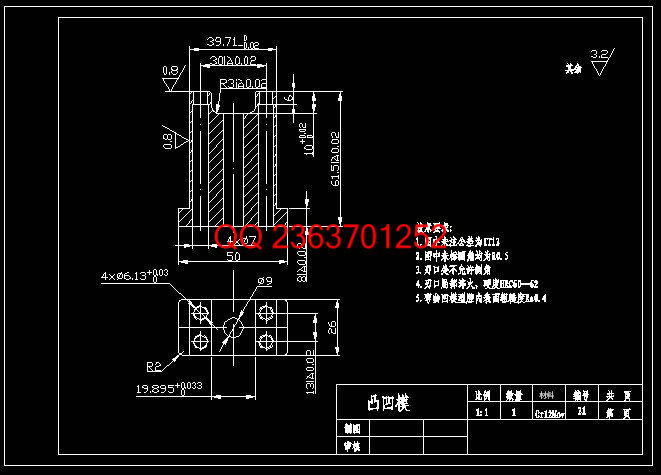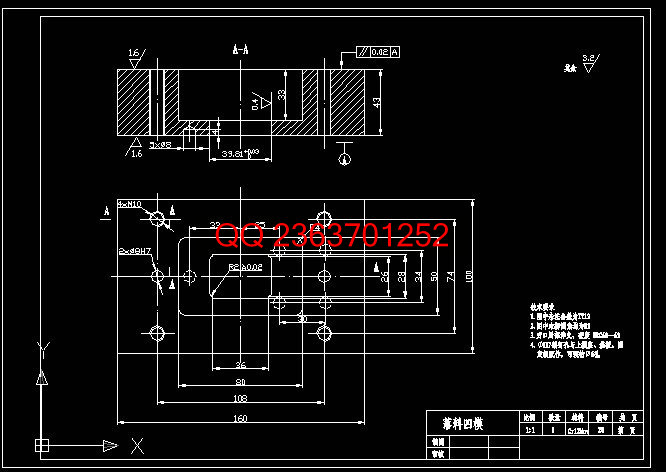|
设计简介 |
设计描述:
文档包括:
Word版说明书一份,50页,约28000字
CAD版本图纸,共20张
毕业设计(论文)任务书
题 目 托架冲压模具设计
1、本论文的目的、意义 模具设计工件是需要非常专业的知识和多年的经验才能胜任的。随着我国机械行业的飞速发展,模具设计工程师越来越短缺。已经严重制约了模具行业的健康发展。在广东、浙江、上海、江苏等地找到五年以上设计经验的模具工程非常困难,而刚刚毕业的模具专业的学生又远远不能满足企业的需要。通过本次毕业设计实践, 采用CAD/CAM(Master CAM、UG、Pro/E)技术可以使设计者从繁沉计算和绘图工件中得到解脱。采用人机结合,各尽所长,充分发挥其人的创造思维能力,控制设计过程,使模具设计趋于合理化。而计算机则发挥其计算分折和储存信息的能力。两者结合,发挥各自的优势,有利于获得最优的设计成果,缩短开发周期。
2、学生应完成的任务 1、工艺分折;2、确定加工方案;3 排样图的设计及材料利用率计算;4、冲裁压力和压力中心计算;5、凸凹模设计;6、凸凹模刃口尺寸的确定;7、其它零件的设计;8、压力机的选择; 9、后附翻译和实习报告
3、论文各部分内容及时间分配:(共 12 周)
第一部分工艺分折、确定加工方案、收集资料 ( 2周)
第二部分排样图的设计及材料利用率计算、冲裁压力和压力中心计算( 2周)
第三部分凸凹模设计、凸凹模刃口尺寸的确定 ( 4周)
第四部分其它零件的设计、压力机的选择 ( 2周)
第五部分 写说明书及翻译 ( 1周)
评阅及答辩 ( 1周)
备 注 参考文献: 沈兴东,韩森和 《冲压设计与模具设计》山东科学技术出版社,2005年;翁其金《冷冲压技术》机械工程出版社,2004年;王芳《冲压设计与模具设计》机械工程出版社,2002年 郑家贤《冲压工艺与模具设计实用技术》机械工业出版社 2004年
摘 要
冲压模具在实际工业生产中应用广泛。在传统的工业生产中,工人生产的劳动强度大、劳动量大,严重影响生产效率的提高。随着当今科技的发展, 工业生产中模具的使用已经越来越引起人们的重视,而被大量应用到工业生产中来。冲压模具的自动送料技术也投入到实际的生产中,冲压模具可以大大的提高劳动生产效率,减轻工人负担,具有重要的技术进步意义和经济价值。
本文提出采用模具来生产托架的新工艺,并针对某规格夹具托架设计了复合模。该模具设计的难点主要是如何解决好零件中的孔冲裁、确定模具结构、如何进行模具的制造及冲裁方案选定等。本文结合托架的特点,具体解决了压力机的选择与校核、凸模和凹模刃口尺寸计算及结构设计、定位方案设计、卸料方式的设计、主要模具零件的加工工艺、标准零件的选用、模具的装配等一系列的设计工作,这些设计可为类似的零件模具设计提供现实的指导意义。此次模具设计的突出特点是尝试使用复杂的复合模具,解决常规冲压工艺模具套数多、工艺路线长、生产成本高、效率低等缺点,并为以后此类零件冲压工艺的编制及模具设计提供了可靠的依据。
本文介绍的模具实例结构简单实用,使用方便可靠,对类似工件的大批量生产具有一定的参考作用。
关键词 冲模;复合模;冲裁力;冲裁间隙
Abstract
Punching die has been widely used in industrial production. In the traditional industrial production, the worker work very hard, and there are too much work, so the efficiency is low. With the development of the science and technology nowadays, the use of punching die in the industial production gain more attention, and be used in the industrial production more and more. Self-acting feed technology of punching die is also used in production, punching die could increase the efficience of production and could alleviate the work burden,so it has significant meaning in technologic progress and economic value.
This Article proposes using mold to produce retainer of the new technology, And against a standard fixture retainer design of the compound dies. The main problems of this mold design is how to solve retainer of punching holes, determine mold structure, how to manufacturing the mold and selected blanking programs and so on. This Article Combine the characteristics of retainer, concretely solve the choice and verify check of the press machine, the numeration and structure design of the point dimension of punch and matrix, the locating project design, the method of stripper, the main mold parts processing, the choice of standard parts, the design of the model assemble. These designs can provide realistic guiding significance for similar mold design. But the characteristics of the design is to try to using the complicate dies. To solve the problem of original process, such as large numbers of die, long process of technology, high production cost, low efficiency, difficulty in keeping symmetry of working parts are solved, and a reliable evidence for the workout of stamping process and die design of these parts is provided.
The dies here discussed can be easily made, conveniently used, and safely operated. And it could be used as the reference in the large scale production of similar workpieces.
key words dies; compound dies; blanking force; blanking dearance
目 录
第1章 绪论 1
1.1模具行业 1
1.2国内外模具发展状况及趋势 1
1.3本次设计的主要方向、内容及目的 2
第2章 冲压工艺与模具设计 4
2.1 冲压件工艺分析 4
2.2 工艺方案及模具结构类型 4
2.3 排样及搭边 5
2.4 冲压力与压力中心计算 6
2.4.1 冲压力 6
2.4.2 压力中心 7
2.5 工作零件刃口尺寸计算 8
2.5.1 刃口尺寸确定的原则 8
2.5.2 刃口尺寸确定的方法 9
2.6 工作零件结构尺寸 11
2.6.1 落料凹模板尺寸 11
2.6.2 落料凸模尺寸 11
2.6.3 冲孔凸模尺寸 11
2.7 其它模具零件结构尺寸及模架选用 12
2.8 压力机的规格选用 12
2.9 模具装配图 13
2.10 模具零件图 14
2.11 零件技术要求 24
第3章 模具制造 25
3.1 主要模具零件及其加工工艺过程 25
3.1.1 落料凹模加工工艺过程 26
3.1.2 冲孔凸模加工工艺过程 26
3.1.3 落料凸模加工工艺过程 27
3.1.4 凸模固定板加工工艺过程 28
3.1.5 落料凸模固定板加工工艺过程 28
3.1.6 卸料板加工工艺过程 29
3.1.7 上垫板加工工艺过程 29
3.1.8 下垫板加工工艺过程 30
3.1.9 空心垫板加工工艺过程 30
3.1.10 推件块加工工艺过程 31
3.1.11 上模座加工工艺过程 31
3.1.12 下模座加工工艺过程 32
3.2 其余模具标准零件 32
3.2.1 固定挡料销及导料销 32
3.2.2 推杆 33
3.2.3 防转销 33
3.2.4 圆柱销 34
3.2.5 卸料螺钉 35
3.2.6 内六角圆柱头螺钉 35
3.2.7 模柄 36
3.2.8 卸料弹簧 37
3.2.9 导柱导套 38
3.2.10 模座 38
第4章 模具装配与调试 40
4.1 模具装配特点 40
4.2 装配技术要求 40
4.3 装配过程 41
4.3.1 常用的装模工具 41
4.3.2 模具的装配 41
4.4 装模与试模 43
4.4.1 模具的安装 43
4.4.2 模具的调试 44
4.5 检验和验收技术条件 45
4.6 使用规定 46
4.7 冲模设计的审核项目 46
4.8 模具制造者的保证 47
结论 49
致谢 50
参考文献 51
|










